
It’s time for no rules and less stress! This is an opportunity for students to write freely at any given moment. This activity can be instructed a number of ways. Children enjoy this strategy because there are no specific rules. As they become more familiar and confident with writing strategies, you will be amazed at what they are able to produce in a short amount of time.
Objective: To write descriptively with no rules. Free-writes can be used daily or weekly.
Age: 5+
Time: 20 minutes (writing varies)
Grades: K-3
Materials:
- Picture books or stories
- Non-fiction books
- Colored pencils or crayons
- Lined paper
- Writing journal
- Pre-cut frames
- Pencil
- Construction paper
- Scissors
- Stapler
- Timer (optional)
Free-Write Lesson Plan
Writing Journal: This activity is a one time activity and is optional. It is not included in the 20 minutes:
- Create a Free Write Journal using oak tag and/or construction paper. You may decide to sponge paint, color or stencil a cover. Allow the children to be as creative as possible. You can also provide the journals for students and have them decorate the pre-made ones.
- You will need free-writes pages to attach as well. Include space for drawing and lines for writing. Lines can be added to back-side of journal page as well.
Note: Younger or more challenged children may need to dictate their responses until their written application improves.

Instructions:
- Use a pre-cut mat frame or make one out of construction paper or oak tag paper. Do not decorate it. Keep the frame plain so as not to be too distracting when you use it. Laminating the frame is optional, but will be helpful to use throughout the academic year.
- Allow the children to read picture books/stories or non-fiction literature for 5 minutes. Time may vary due to age and adaptability.
- When time is ‘up’, the kids place the frame on one of the pictures. The frame may not cover the entire picture. Therefore, encourage the children to free-write only about the picture in the frame for 5 or 10 minutes. Do not concern the children with grammar or spelling. Just promote writing with No Stress!
- Writing can include, but not be limited to: descriptive words (i.e. adjectives, or action words such as verbs and adverbs), list nouns, descriptive phrases, elaborated sentences, descriptive paragraph, poetry, or even an informational paragraph for non-fiction. Remember, they write freely unless you want to direct your instruction.
- Students can sketch their picture after their timed writing is complete (optional)
- Share aloud as “Quick Reads” and discuss the experience (see other ways to use this Lesson).
Evaluation
Remember, this strategy gives your students the experience of writing in a timed situation, thus, preparing them to quickly write and be comfortable responding to details and perhaps partial comprehension at a given moment. It’s just practice!
Depending on the skill you are reinforcing, this activity lends itself easily to assessing descriptive sentences, elaborative sentences, descriptive words and the use of adjectives, verbs and nouns. It can also reinforce paragraph writing and poetic elements as well. Be sure to inform your students about your expectations. Perhaps you can orally assess a particular skill by asking the children to tell you to name the verbs, or nouns and adjectives. Their written application will already be completed, therefore, you may want to assess for punctuation and mechanics/ grammar in a timed situation and record their growth over time. Try using the information to direct your free-writes in the future. Another way to organize your anecdotal notes can be to create a skill chart and check off the skills that have been mastered or need more improvement. Remember, by keeping a writing journal, you will have an on-going progress assessment as well. (See other ways to use this lesson).
Other Ways to Use This Lesson:
Note: Time can vary depending on the age and ability. Children may benefit by writing for longer periods of time in the beginning and then increasingly less and they progress weekly.
Remember to allow the opportunity for your learners to write “visually”. This technique will work for concrete learners who may rely on writing about exactly what they ‘see’ and your more experienced/confident writers will extend their creative thinking beyond the picture and rely more on previous knowledge. Moreover, all learning styles will benefit from this visual approach to written expression. This quick visual experience will easily enhance narrative, descriptive, expository, and poetic writing. Let them see the picture before they write. Train them early to ‘visualize’ and see the details. Guaranteed, your students will feel more confident as they progress with this approach.
This lesson can focus on one skill at a time. Perhaps you are introducing descriptive sentences; allow the children to draw on previous knowledge from their reading, as well as be inspired by the pictures. Have the children try free writes, writing only descriptive sentences, every week, collect the journals and allow the class to share them aloud. More experienced writers will naturally write paragraphs, so let them.
You may want to have the children only write phrases or single words like verbs, nouns, or adjectives to describe what is in the picture. Keep an on-going chart or personal dictionary to record these words and use again for writing. You may want to extend this activity and list antonyms and synonyms to match these words as well. You can put these words on index cards and keep in a basket for kids to use and write their own sentences with. Be creative!
Additionally, you can use this activity every week for practice along with reinforcing various topics throughout the year. For instance, you may be reading about birds one week, so allow the children to do this activity using non-fiction and picture books of birds. Just place the frame on top of the visual and write for a specified time directed by the teacher. Celebrate the writing or dictation for younger children and discuss their creative ideas.
About the Author:

Kim Waltmire is a state and national award-winning educator. She holds an honorary seat with the 2006 USA Today All-Star Teacher team. Kim is a graduate from CCSU with a Masters in Early Childhood Education. She published a writing & literacy book; Picturesque Writing, now self-published as The Art of Visual Writing for elementary teachers K-5. Kim also published a Read-Along Series for primary grades, coupled with spelling, grammar, science and social studies lessons for k-12 with a home-school company. Her writing and Project Based Learning strategies were recognized and published in the Creative Classroom Teacher’s magazine; May/June 1998 issue. She was recognized for her educational contributions and Project Based Learning by Oprah Winfrey, interviewed on CNN, Fox News, and honored by the CT State Governor several times. Kim has taught elementary school for 28 years and presently an Educational Literacy Consultant. Kim’s passion is teaching writing literacy for all learning styles.
- Twitter: @kwaltmire
- LinkedIn: www.linkedin.com/in/kimwaltmire/
- Website: www.visualccl.com







